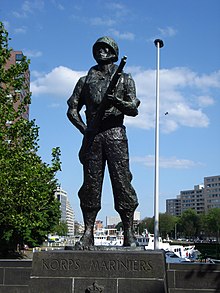The Royal Netherlands Navy is the naval force of the Kingdom of the Netherlands. It is one of the four Netherlands Armed Forces. It was founded on 8 January 1488, making it the third oldest naval force in the world.
Defense on Aruba is the responsibility of the Kingdom of the Netherlands. The Netherlands Military forces that protect Aruba include the Royal Netherlands Navy, the Netherlands Marine Corps and the Netherlands Coastguard. There is also a small indigenous "Arubaanse Militie" of about platoon strength, and a shared Dutch Caribbean Coast Guard consisting of three Damen Stan 4100 patrol boats.

The Netherlands Marine Corps is the elite naval infantry corps of the Royal Netherlands Navy, one of the four Armed Forces of the Kingdom of the Netherlands. The marines trace their origins to the establishment of the Regiment de Marine on 10 December 1665, by the then grand pensionary of the Dutch Republic, Johan de Witt and famous Admiral Michiel de Ruyter. It is the second-oldest still-active marine corps in the world.

HNLMS Tromp was the lead ship of the Tromp-class destroyer leaders built for the Royal Netherlands Navy. Built just prior to World War II, the ship served mainly in the Pacific and Indian Oceans against the Japanese, being based out of Sydney, Fremantle and Trincomalee where she served alongside British, Australian and US warships. After the war, she returned to the Netherlands; after 1949,Tromp was used as a training and accommodation ship, before being decommissioned in 1955, and scrapped in 1969.

Despite Dutch neutrality, Nazi Germany invaded the Netherlands on 10 May 1940 as part of Fall Gelb. On 15 May 1940, one day after the bombing of Rotterdam, the Dutch forces surrendered. The Dutch government and the royal family relocated to London. Princess Juliana and her children sought refuge in Ottawa, Canada until after the war.
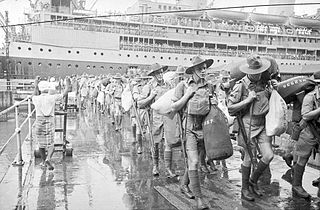
The 8th Division was an infantry division of the Australian Army, formed during World War II as part of the all-volunteer Second Australian Imperial Force. The 8th Division was raised from volunteers for overseas service from July 1940 onwards. Consisting of three infantry brigades, the intention had been to deploy the division to the Middle East to join the other Australian divisions, but as war with Japan loomed in 1941, the division was divided into four separate forces, which were deployed in different parts of the Asia-Pacific region. All of these formations were destroyed as fighting forces by the end of February 1942 during the fighting for Singapore, and in Rabaul, Ambon, and Timor. Most members of the division became prisoners of war, waiting until the war ended in late 1945 to be liberated. One in three died in captivity.
The Battle of Ambon occurred Ambon Island in the Dutch East Indies, as part of the Japanese offensive on the Dutch colony during World War II. In the face of a combined defense by Dutch and Australian troops, Japanese forces conquered the island and its strategic airfield in several days. In the aftermath of the fighting, a major massacre of many Dutch and Australian prisoners of war by the Imperial Japanese Army (IJA) followed. Following the war, many of the IJA personnel were tried for war crimes.
The Netherlands entered World War II on May 10, 1940, when invading German forces quickly overran the country. On December 7, 1941, after the attack on Pearl Harbor, the Netherlands government in exile also declared war on Japan. Operation Market Garden, which started in 1944, liberated the southern and eastern parts of the country, but full liberation did not come until the surrender of Germany on May 5, 1945.

The Dutch resistance to the German occupation of the Netherlands during World War II can be mainly characterized as non-violent. The primary organizers were the Communist Party, churches, and independent groups. Over 300,000 people were hidden from German authorities in the autumn of 1944 by 60,000 to 200,000 illegal landlords and caretakers. These activities were tolerated knowingly by some one million people, including a few individuals among German occupiers and military.
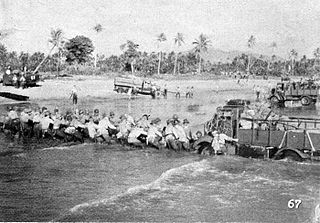
The Dutch East Indies campaign of 1941–1942 was the conquest of the Dutch East Indies by forces of the Empire of Japan in the early days of the Pacific campaign of World War II. Allied forces attempted unsuccessfully to defend the islands. The East Indies were targeted by the Japanese for their rich oil resources which would become a vital asset during the war. The campaign and subsequent three-and-a-half-year Japanese occupation was also a major factor in the end of Dutch colonial rule in the region.

The Battle of Guam was an engagement during the Pacific War in World War II, and took place from 8 December to 10 December 1941 on Guam in the Mariana Islands between Japan and the United States. The American garrison was defeated by Japanese forces on 10 December, which resulted in an occupation until the Second Battle of Guam in 1944.

ToshinariShōji was a major general in the Imperial Japanese Army during the Pacific campaign in World War II.

The Indies Monument is a memorial in The Hague in memory of all Dutch citizens and soldiers killed during World War II as a result of the Japanese occupation (1942–1945) of the former Dutch East Indies. It is dedicated to all who died in battle, in prison camps or during forced labor. As stated in the mission statement of the 15 August 1945 Commemoration Foundation, it is also:
A place where you can pass on to your children the part of your childhood spent in the Dutch East Indies

HNLMS Willem van der Zaan (ML-2/N82/F824/A880) was a minelayer of the Royal Netherlands Navy that was commissioned only days before the start of World War II in September 1939. She served in England, in the Netherlands East Indies, and as a convoy escort in the Indian Ocean before returning to The Netherlands in 1945. She then served again in the Netherlands East Indies and Dutch West Indies until 1950 when she was rebuilt and reclassified as a frigate. From 1961 she was used as an accommodation and repair ship until struck in 1970 and sold for scrap. She was named in honour of the 17th century Schout-bij-nacht Willem Van Der Zaan.
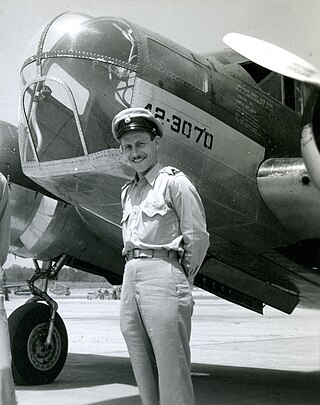
Lt. Colonel Jhr. Bodo Sandberg was a fighter pilot in the Royal Netherlands Air Force and 'Engelandvaarder' during World War II. He was awarded the Cross of Merit and the Airman's Cross for his bravery during the German invasion of May 1940.
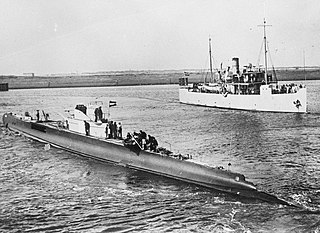
K XVII was one of five K XIV-class submarines built for the Royal Netherlands Navy. She served during World War II.

Engelandvaarder, was the term given during the Second World War to men and women who attempted to escape from the Netherlands across over 100 miles of the North Sea to reach England and freedom. Only about one in ten were successful in the crossing, with most just disappearing in the sea. Once they reached England many joined the Allied forces to help free their country from Nazi Germany. The period covered is between the capitulation of the Dutch armed forces on 15 May 1940 and the Allied invasion of Normandy on 6 June 1944 (D-Day).
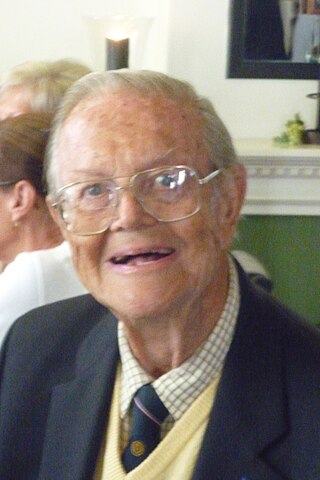
Pieter Johannes Hoets was a Dutch Engelandvaarder, an active Dutch resistance fighter against the Nazi occupation of the Netherlands in WW-II.

The Free Dutch Forces refers to the Dutch military formations of the Dutch government-in-exile and its colonies that were formed to fight alongside the Western Allies against Nazi Germany and its allies during World War II following the Dutch surrender in May 1940.
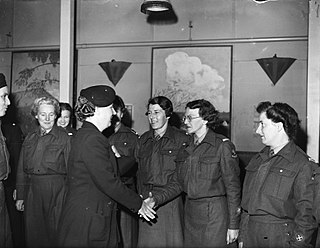
The Royal Netherlands Army (Volunteer) Women's Auxiliary Corps was the women's branch of the Royal Army of the Netherlands Armed Forces from 1943 to 1952. The VHK was the predecessor of the Royal Netherlands Army Women's Department, which existed from 1951 to 1982.
